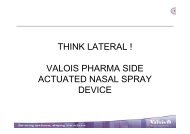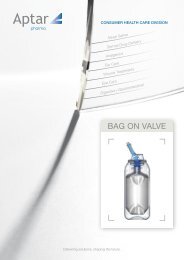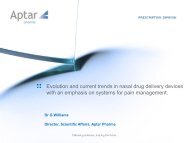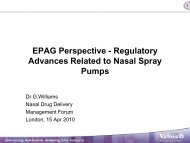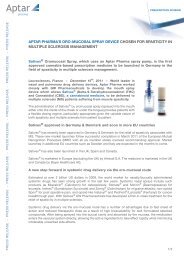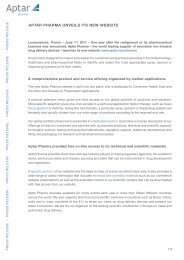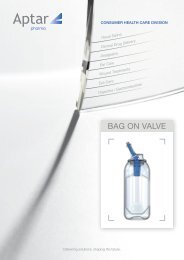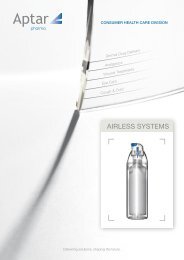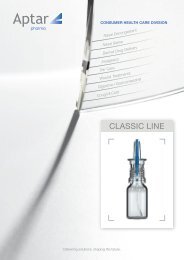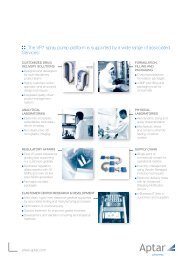Multi-Dose Container for Nasal and Ophthalmic Drugs: A ... - Aptar
Multi-Dose Container for Nasal and Ophthalmic Drugs: A ... - Aptar
Multi-Dose Container for Nasal and Ophthalmic Drugs: A ... - Aptar
Create successful ePaper yourself
Turn your PDF publications into a flip-book with our unique Google optimized e-Paper software.
<strong>Multi</strong>-<strong>Dose</strong> <strong>Container</strong> <strong>for</strong> <strong>Nasal</strong> <strong>and</strong> <strong>Ophthalmic</strong> <strong>Drugs</strong>: A Preservative Free Future 517<br />
3.4.4 Shot weight <strong>and</strong> delivered dose<br />
Methods <strong>for</strong> the measurement of shot weight or delivered dose <strong>and</strong> acceptance criteria are<br />
well described in the appropriate guidelines. It should be recognized, that there are some<br />
differences between European <strong>and</strong> US guidelines which should be considered during<br />
development.<br />
The volume of the metering chamber will define the delivered dose <strong>for</strong> a primed pump. This<br />
works normally fine <strong>for</strong> water or saline when the right actuation parameters (<strong>for</strong>ce, stroke<br />
acceleration) are used. Depending on surface tension <strong>and</strong> viscosity of the product, air may<br />
be trapped in the dosing chamber influencing priming <strong>and</strong> dose accuracy. Similar problems<br />
may occur when air bubbles come into the dip tube. Also too low actuation <strong>for</strong>ces may lead<br />
to partial metering. To overcome the problem of partial metering, so called “userindependent”<br />
spray pumps were developed but are not widely used by the industry yet.<br />
4. Bottles<br />
Bottles or containers are an integral part of drug delivery devices <strong>and</strong> will also influence the<br />
general appearance of the final product. Special shapes may be used to differentiate a<br />
product from competitors. Glass bottles are less prone to cause interactions <strong>and</strong> will give<br />
good protection to the <strong>for</strong>mulation even during long storage intervals. Sometimes the glass<br />
can influence the stability of the <strong>for</strong>mulation (change in pH, release of trace metals). This<br />
depends of course on the quality of the glass which is described by its hydrolytic class<br />
(hydrolytic class I-III is normally used <strong>for</strong> pharmaceutical products). The disadvantages<br />
which glass bottles may have are the higher weight <strong>and</strong> the risk to break when dropped.<br />
Bottles made of plastic material (e.g. polyethylene, polypropylene, PET) are sometimes used<br />
<strong>for</strong> nasal sprays but are m<strong>and</strong>atory <strong>for</strong> ophthalmic droppers because squeezing the bottles is<br />
needed to dispense the product. Pump supplier will most likely not manufacture these<br />
bottles themselves because a complete different technology is used. Parts <strong>for</strong> spray pumps<br />
or droppers are quite exclusively made by injection molding which gives high precision.<br />
Plastic bottle manufacturers use a process called blow-molding. The general principle is to<br />
make a hollow raw part <strong>and</strong> then blowing up the material to the final dimensions. The most<br />
important disadvantage <strong>for</strong> all bottles made of plastic material is evaporation/weight loss.<br />
Plastic materials are not a perfect barrier <strong>for</strong> gas or water evaporation. This problem can be<br />
tackled using laminated materials but these are more expensive. Another potential risk has<br />
to be considered: inks <strong>and</strong> adhesives from labels may migrate through the bottle wall <strong>and</strong><br />
leach into the <strong>for</strong>mulation.<br />
Pure mechanics but critical <strong>for</strong> all types of bottles: the bottle opening must fit the delivery<br />
device exactly. It needs to be tested <strong>and</strong> dimensions need to be controlled because variations<br />
may cause leakages or destroy the closure during final assembly. To avoid troubles,<br />
consultation of the delivery system supplier is highly recommended as these companies are<br />
experienced in managing this interface. The pump supplier should be able to recommend a<br />
range of suited bottles from suppliers which provide reliable quality. Be<strong>for</strong>e switching to<br />
another bottle or bottle supplier, the compatibility with the device should be checked in<br />
advance.<br />
5. Use of preservatives in multi-dose products<br />
<strong>Multi</strong>-dose dispensers are widely used <strong>for</strong> the administration of liquid nasal, ophthalmic or<br />
dermal drugs because they are convenient <strong>and</strong> cost effective. To prevent degradation of the



